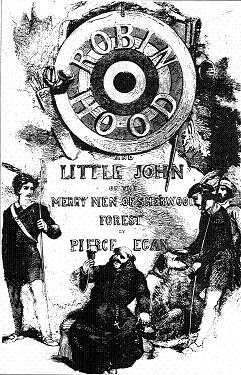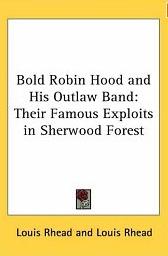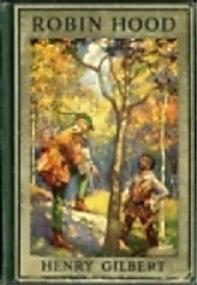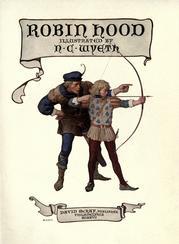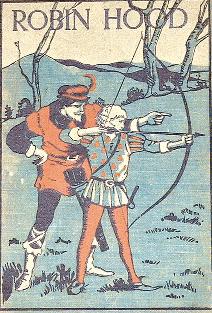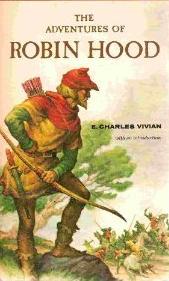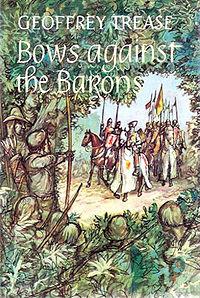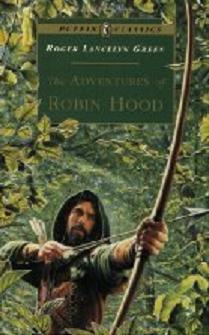Children’s Books
It was as a boy that William Wordsworth (1770-1850) first encountered in the chapbooks ‘the Wishing-Cap/of Fortunatus, and the invisible Coat/Of Jack the Giant-Killer, Robin Hood/And Sabra in the forest with St George.(1)During Wordsworth’s own life-time a change occurred in which writers and publishers were able to produce versions of the Robin Hood tales addressed specifically to young readers. The many Robin Hood Garlands of the late 18th century may have been read by more children that adults, but with their traditionally coarse humour, they were not written specifically for children; however not long after 1800, the situation began to alter. The emergence of a Robin Hood ballad anthology in folding toy-book form, the appearance of more and bigger illustrations, and the increased popularity of connected prose narratives rather than the traditional verse garlands were the main elements in the revolution in book-production for children. However, children’s editions of the traditional chapbooks were still being produced in the 1840s.(2) In the nineteenth century the number of books presenting the life and adventures of Robin Hood for young readers was quite low. Apart from prose rendering of the old Robin Hood ballads in the beginning of that century, there was little else. In 1804 Benjamin Tabart brought out a 40-page prose version followed by William Darton’s children’s story in 1818.(3)The popularity of Scott’s Ivanhoe prompted the publisher Longman, to issue a new edition of Joseph Ritson’s great late eighteenth century work on the Robin Hood ballads in 1820, designed as ‘a book which could with propriety be put into the hands of young persons’.(4)The first full-length story-version of Robin Hood for children appears to be Joseph Cundall’s 1841 novel Robin Hood and his Merry Foresters. It was a fairly short book, intended for young children. The first substantial novel, for boy readers, written by John B. Marsh, came out in 1865.(5)The prolific Victorian boys writers such as W.H.G. Kingston, Thomas Mayne Reid, R.M. Ballantyne, G.A. Henty, Gordon Stables and many others, did not write novels about the greenwood hero. Robin Hood did appear as a very minor figure in a Henty novel, and G.M Fenn’s Young Robin Hood was a tale for young children about a friendship between two Robins, the outlaw himself and the sheriff’s son.(6)The up-market boys magazines such as Routledge’s Every Boy’s Magazine and the Religious Tract Society’s Boy’s Own Paper also ignored the legend.
1. Wordsworth’s The Prelude, V, lines 341-4 (ed. E. de Selincourt, Oxford, 1933, p. 77).
2. Thus Gammer Gurton’s famous histories of Sir Guy of Warwick ….. Robin Hood, newly revised and amended by Ambrose Merton (Joseph Cundall, Westminster, 1846) followed the texts of the Aldermary chapbooks very closely.
3. The History of Robin Hood, item 65 in Marjorie Moon, Benjamin Tabart’s Juvenile Library (Winchester: St Pauls bibliographies, 1990); Robin Hood, (London: William Darton, 1818, reprinted with new illustrations in 1822).
4. Preface to Robin Hood: A Collection of all the Ancient Poems, Songs and Ballads, (London: Longman, 1820), p. (vii).
5. John B. Marsh, The Life and Adventures of Robin Hood, (London: Routledge, c. 1865).
6. See G.A. Henty, Winning His Spurs: A Tale of the Crusades (London: Sampson Low & Co., 1882) and G.M. Fenn, Young Robin Hood (London: Ernest Nister; New York: E.P. Dutton, (1899).
If we go looking for Robin Hood in children’s literature of the nineteenth century we need to set aside the books issued by the respectable publishing houses and seek him in the cheap magazines and serialised novels put out by the Victorian penny press. The starting point for this search is the popular fiction produced for working class readers between 1830 and 1850. Penny-part novels of this period regularly dealt with crime and ‘low life’ in London, the adventures of pirates, smugglers and highwaymen, and the doing of Vampires and other creatures of the night. The characters included the infamous Sweeney Todd, Varny the Vampire, the highwayman Dick Turpin, and Claude Duval, the burglars Jack Sheppard and Charles Peace, and the many others whose lives were chronicled in numerous editions of the Newgate Calendar. This fiction was not directed at young readers but there is some evidence that they were part of the audience. It was one of the many small printer publishers operating at this time who brought out the first Robin Hood novel in weekly parts. From the autumn of 1839 to the summer of 1840, Foster and Hextall published a novel by Pierce Egan the younger in 41 penny weekly parts entitled Robin Hood and Little John; or, The Merry Men of Sherwood Forest. Egan’s novel is divided into three books. In book I, Baron de Beaseant’s illegitimate son Robyn is deposited with a forester couple called Gilbert and Margaret Head, to be brought up as their own son in Sherwood. In book II six years later, Robin is rescuing Marian from Norman lords determined to rape her. Book III returns in part to the legend as recounted in the old ballads, introducing the well-known characters Guy of Gisborne, the Bishop of Hereford, and Sir Richard of the Lee. Egan’s penny-part novel was very successful, and reprints were called in for 1840, 1843, 1844 and 1847 and a revised penny-part edition in 1850. Not only did Egan’s novel become a boys book, it inspired a whole Robin Hood industry. Towards the end of its first serialisation, the original publisher, Foster and Hextall, brought out a cheap edition of the old ballads, (1840). A companion volume by J.H. Stocqueler, Maid Marian, the Forest Queen, followed in 31 weekly parts (1849). Egan’s novel served as a template for many later versions of the legend. Little John and Will Scarlett; or, The Outlaws of Sherwood Forest appears to have been first issued around 1865 in 40 eight-page penny parts. The novel is basically a rehash of Egan’s tale, with Robin Hood as the main character, but neither style nor theme suggest that young readers were being targeted. (In this period, many children’s stories also avoid the outlaw’s name in their main titles).
It had been know since the 1850s that boys were eager to read adventure fiction, but it had to be affordable. In the 1860s a number of factors favoured the emergence of a penny press for the young: paper cheaper than ever before, efficient steam-driven rotary presses, a reliabel distribition network (newsagents), a high proportion of children in the population (particularly in London) and a relatively high level of pre-Education Act child literacy, wage earning boys, and a reservior of unemployed penny-a-liners and illustrators. The first publishing firm to exploit this new situation was the ill-famed Newsagents Publishing Company which issued lurid tales of crime in the mid 1860s such as The Wild boys of London (1864-66) and The Dance of Death (1865-66). The sales were good, but the harsh criticism of such ‘penny dreadfuls’ or ‘penny packets of poison’ led the manager Edwin J. Brett to produce a magazine of a more respectable nature. His Boys of England (1866-99) became the first commercially successful boys weekly magazine. The competition for boys pennies was fierce. The Emmett Brothers brought out their boys magazine Young Englishmen in 1867, then followed with penny-part novels about pirates, robbers and highwaymen. Edward Harrison of Salisbury Square was the publisher who reprinted two Robin Hood novels for boy readers, and his other publications included the long-running Dick Turpin weekly serial Black Bess (1863-65) and a New Newgate Calendar for boys (1863-65), as well as more conventional children’s magazines. The Emmett brothers published the first penny-part Robin Hood novel written specifically for boys. Written by George Emmett and entitled Robin Hood and the Outlaws of Sherwood Forest, it appeared in 52 penny-parts from early 1868 to early 1869. For about a quarter of a century the text of this book was available in a cheap form to many thousands of office, factory and schoolboys. Whilst George Emmett’s tale was still running, his publishing rival Edwin J. Brett responded with ‘Robin Hood and His Merry Men’ which appeared in Brett’s weekly Boys of England in the winter of 1868-69. The story owes much to pantomime and to Punch and in particular leans heavily on Francis Burnand’s ‘original farce’-as he called it- Robin Hood; or, the Foresters Fate which had been drawing large audiences in the mid nineteenth century.(7)
7. Gable’s Bibliography of Robin Hood has acting editions he dates 1850 and 1862, p. 19. On Sir Francis Burnand, see Knight, Robin Hood; A Complete Study, pp. 195-6.
More Robin Hoods followed in Victorian boy’s weeklies. The Merry Men cavorted in novel-length serialised stories in the penny weeklies Boys of England (1868-69, 1877 and 1883), The Young Briton (1871-72 and 1874), Our Young Folk’s Weekly Budget (1873-74), Young Britannia (1885-86), Young Men of Great Britain (1885-86), Boys and Girls (1887), Nuggets (1896), The Boys Comic Journal (1897) and British Boys (1897). In ‘Bold Robin Hood’ (1873-74), Marian is the angel in the forest cave, in ‘Allen-a-Dale: The Comrade of Bold Robin Hood’ (1885-86), Allen avenges the death of his murdered father, and in ‘The Prince of Archers’ (1883), Little John appears as just that-little (and fat).
Towards the end of the nineteenth century, a new publisher, the Aldine Publishing Company, introduced a new format into popular juvenile literature. The company brought the first of its ‘libraries’ in 1887, the Boys First-Rate Pocket Library, followed by O’er Land and Sea (1890), Invention, Travel & Adventure (1894) and many others. These booklets were basically abridged reprints of American dime novels relating the adventures of Buffalo Bill, Deadwood Dick and other heroes of the Wild West. They were usually pocket-sized magazines of 32 pages at the regular price of one penny each. In 1901 Aldine embarked on a program of ‘libraries’, reviving British outlaws and highwaymen popular half a century before. The flagship was Robin Hood (1901-6) and it’s success led Aldine to float the companion ‘libraries’ Dick Turpin (1902-9), Claude Duval (1902-6), Rob Roy (1903-4) and Jack Sheppard (1904-6). The first number in Aldine’s Robin Hood is entitled ‘Sweet Liberty or Death’, this being the war-cry of young Robin Fitzooth. As the stories progress in this ‘library’ a succession of Robins dispatch a series of Norman villians as one sheriff is replaced by another. There are damsels a-plenty for the Merry Men to rescue and a whole gallery of deformed and supernatural beings to contend with. It is interesting to note that Robin Hood first appeared on the screen in 1908. (see Movies)
By Edwardian times, it was the Amalgamated Press of Alfred Harmsworth that was the main producer of popular juvenile fiction. His first boys weeklies had come out in the mid 1890s at the low price of a halfpenny: Marvel (1893), The Union Jack (1894), Pluck (1894) and The Boys Friend (1895). Harmsworth was intent on killing off the penny dreadful, in other words the penny magazines put out by his competitors. He did push his competitors to the wall: Charles Fox sold his Hogarth House stock to the printers Sully and Ford, the newly renamed firm Edwin J. Brett Ltd was close to collapse, and by 1906 Aldine was in debt. At first, the Amalgamated Press avoided the literature of roguery that was popular in the preceeding half century, but gradually the popular heroes – Dick Turpin, Jack Sheppard, Robin Hood and others did enter Harmsworth’s boys magazines with the dubious claim that these new outlaw tales were not ‘Blood and thunder trash … but true stories of real life’. However, The Amalgamated Press produced few Robin Hood stories for boys up to 1914, apart from what appeared in The Boys Friend in 1903-5 and 1909-10, a single short story in The Union Jack in 1904, and just one out of the 764 numbers of the first series of The Boys Friend Library of c. 1913.(8)
8. There are at least 295 nineteenth-and early twentieth-century boys magazines on record. A collection can be found in The British Library.
Robin Hood’s fortunes in boys weeklies declined even further after the Great War. Apart from the Amalgamated Press’s Robin Hood Library of 1919-20, there was only the occasional Sherwood story in inter-war boys weeklies. Mainstream children’s publishers were now including Robin Hoods in their lists; some of the main publishers were Blackwood and Sons, J.M. Dent and Sons, George Routledge and Sons, Ward Lock and Co. and Wells Gardner and Darton. In the 1920s the Merry Men moved into a new area of popular children’s literature – ‘bumper books’ and comics. ‘Bumper Books’ were cheap books printed on thick lightweight paper enclosed in matt boards. Robin Hoods were published in this format by Aldine, J. Coker and Co., George G. Harrap, John F. Shaw (one of them for Marks and Spencers), Ward Lock and Co. and Wells Gardner and Darton.
It could be argued that Egan’s novel has influenced the development of the outlaw legend more than any other work since Ivanhoe. Perhaps the greatest tribute to the popularity of Egan’s work, was its use by Alexandre Dumas as the basis for his own two Robin Hood novels, Le Prince des Voleurs (1872) and Robin Hood Le Proscrit (1873), books that inspired great interest in ‘Robin des Bois’ (Robin of the Wood). Robin Hood’s conquest of late nineteenth-century America probably reached it’s climax with Howard Pyle’s illustrated The Merry Adventures of Robin Hood of Great Renown in Nottinghamshire, first published in New York in 1883. Some of the most popular prose re-telling of the Robin Hood stories in the first half of the 20th century were Henry Gilbert’s Robin Hood and the Men of the Greenwood (various editions since 1912), and E. Charles Vivian’s The Adventures of Robin Hood (1927). There have been attempts to provide a novel emphasis such as the political interpretations of the story in Geoffrey Trease’s Bows Against the Barons (1934). There are countless modern re-tellings of the greenwood tales, but perhaps the most successful of the more recent versions of the Robin Hood saga for children are those such as R.L. Green’s The Adventures of Robin Hood (London, 1956), which have treated the original ballad stories with sensitivity and respect.
The above section contains information found in Robin Hood in Boys Weeklies to 1914, by Kevin Carpenter. This article is in Chapter 3 of Popular Children’s Literture in Great Britain, edited by Julia Briggs, Dennis Butts and M. O. Grenby, (Ashgate Publishing Limited, Hamshire, England, 2008). There is also information found in Rymes of Robyn Hood, (Dobson and Taylor), pp. 59, 60, 61.
.
Other Children’s Books and Audio
c. 1822 The History of Robin Hood, Captain of the Merry Outlaws of Sherwood Forest (Alnwick: W. Davison), Hockliffe Collection, Polhill Library, University of Bedfordshire.
c. 1825 Sherwood Forest, or, Robin Hood and Little John (Alfred Mills) A children’s tale of Robin Hood with coloured engravings and a ‘Moral’ section at the end.
1892 Maid Marian and Robin Hood: A Romance of Old Sherwood Forest (J.E. Muddock) Illustrated by Stanley L. Wood.
1903/1905 Robin Hood, His Book (Eva March Tappan) A collection of the most popular ballads. Illustrated by Charlotte Harding.
1905 Bold Robin and His Forest Rangers (Caroline Brown) A retelling of some traditional stories, a fresh approach from other Robin Hood books published in the early 20th century. Includes a chapter that claims to be the origin of the phrase ’round Robin Hood’s barn.’ Some of the chapters were serialized in ‘St. Nicholas’, a popular children’s magazine of the late 19th – early 20th century. Illustrated by F.I. Bennett.
1905 The Tale of Robin Hood and His Merry Men: A New and Original Setting (Elinor M. Buckingham, McKay’s Young Peoples’s Classics) Uses most of the original ballads, with an interesting variation on the legend of Will Scarlet: the author makes use of another outlaw tale, that of Gamelyn. The last chapter also includes the appearance of Roger of Doncaster, whom Robin slays just before he dies. Maid Marian is not mentioned in the story.
1905 The Boy Foresters: A Tale of the Days of Robin Hood (Anne Bowman) The story of three children, Ella, Hubert and Rica, who lived during the time of King Richard. The orphaned children run away to seek their fortune rather than become serfs. They discover that their father, who they thought dead, is part of Robin Hood’s outlaw band.
1909 The Story of Robin Hood and His Merry Men (John Finnemore) There are several reprints of this retelling of the more familiar ballads, with some storytelling similarities to the Louis Rhead edition. Quotes from the ballads are sometimes used as dialogue. Illustrated by Allan Stewart. Reprinted as Robin Hood in 1923 (several reprints) but this edition leaves out the quotes and paraphrases the dialogue. Illustrated by Edwin John Prittie.
1909 Life in the Greenwood-Robin Hood Tales (Marion Florence Lansing, The Open Road Library of Juvenile Literature) A Traditional collection of the old ballads, but also includes the adventures of Adam Bell, Clim of the Clough, and William of Cloudesly. Robin Hood’s Death, is the final chapter, one of the few versions to relate how Robin encountered an old women who mumbled prophecy at a bridge on the trail to Kirklees-a similar storyline appears in the early ballad Robin Hoode his Death (see The Early Ballads). Illustrated by Charles Copeland.
1913 Robin Hood and His Merry Outlaws (Frederick Colin Tilney) A retelling of the more popular ballads of Robin Hood. From the book series Tales for Children From Many Lands. Also published in 1953. Illustrated by Ione Railton.
1914 Robin Hood and His Merry Men (Maude Radford Warren) Robin Hood is presented as the outlawed Earl of Huntington and songs are included in the text. In ‘Suggestions to Teachers’, the author discusses what she felt was necessary alterations to the characters and details of the legend to make the stories more appropriate to children, while keeping the fun and high adventure of the original tales. There are detailed black-and-white drawings. Illustrated by Milo Winter.
1917 Robin Hood and His Merry Men (Rosemary Kingston, pseud. Mary Harriet McGovern) A traditional retelling of the more popular stories, without Marian. Illustrated by Alice Carsey.
1921 Robin Hood and His Mery Men (Sara Hawks Sterling) A traditional collection of the more familiar Robin Hood stories, with a few unfamiliar, such as the tale of Robin Hood and Gambol Gold, and the elopement of Robin’s parents. A later edition was published as a tie-in with the popular 1938 Errol Flynn movie, with cover and pictorial insert from the film. Illustrated by Rowland Wheelwright.
1923 Robin Hood (George Cockburn Harvey) A retelling of the Robin Hood tales. Illustrated by Edwin John Prittie.
1927 Robin Hood and His Merry Men (Arthur Malcolm or Henry Mead Williams) A well-told collection of the traditional stories; Robin is the son of an outcast forester, Hugh Fizooth, and Marian is the daughter of a nobleman named Fitzwalter. Most of the story is set during the reigh of King Henry, and concludes in a similar fashion to the Creswick and McSpadden versions. Also published in 1950.
1928 Robin Hood (Edith Heal, The Windermere Series) Robin is presented as a fatherly older man, devoted to the Virgin Mary, in this extensive Victorian-era retelling. Maid Marian is a child, and Robin’s younger cousin Will Scarlet supplies the romantic interest with Maid Marian as she grows to womanhood. Illustrated by Dan Content.
1928 Robin Hood and His Life in the Merry Greenwood (Rose Yeatman Woolf) Robin Hood is the Earl of Huntingdon, outlawed after seeking to avenge his murdered father. Marian is Robin’s estranged childhood sweetheart who joins him in the greenwood and marries him. The events take place during the absence of King Richard, and Robin’s adventures conclude with his return. The book ends its final chapter with the death of Robin Hood. Black and white illustrations, with a few color plates. Illustrated by Howard Davie.
1930 The Gypsy Caravan (Howard Pease) Betty and Joe travel with the gypsies and meet Robin Hood, Richard the Lionhearted, Roland and other hero figures from European history.
1932 Robin Hood (Ula Waterhouse Echols) A collection of the more popular ballads, similiar in content to Howard Pyle’s. Illustrated by James McCracken.
1940’s Robin Hood and His Merry Foresters (S. C. Johnson) The ballads of Robin Hood are woven into a tale. Similiar in storytelling details to the Carruth version (Greenwood Tales), with Will Scarlet and Will Gamwell being separate characters.
1941 Son of Robin Hood: A Sequel to the Thrilling Adventures of Robin Hood (Paul A. Castleton) In this story Merion is the son of Robin Hood. He and his mother Marian join his outlawed father in Sherwood. The youth makes friends, has adventures, and learns the skills that he hopes will gain him service under the King – and ask for his father’s pardon. The writing style is possibly an imitation of the prose of HowardPyle. Illustrated by C. Richard Schaare.
1948 Robin Hood’s Arrow: Being an account of Dan of the Mill and his adventures with Robin and his Merry Men. (Eugenia Stone) Robin Hood’s adventures are told through the eyes of a small boy named Dickon. Illustrated by Rafaello Busoni.
1950 The Chronicles of Robin Hood (Rosemary Sutcliff) Robin of Locksley, a yeoman landowner, flees to Sherwood with his faithful employees after his enemies plot against him and seize his land. Marian, Robin’s betrothed, flees a dreaded marriage to Roger of Doncaster and marries Robin in the forest. An excellent retelling, with traditional plot elements similar to the Henry Gilbert version. Illustrated by C. Walter Hodges.
1952 The Robin Hood Stories (William Kottmeyer) A simple retelling of the Howard Pyle version. Illustrated by James Cummins.
1952 Story of Robin Hood and His Merry Men (Walt Disney Productions) Based on the screenplay by Lawrence Edward Watkin and adapted by Edward Boyd. Comprehensive retelling of the story as presented in the Disney film. Includes a few color plates from the film, and many well-done black-and-white illustrations throughout.
1953 Adventures of Robin Hood (Eleanor Graham Vance, London) A storybook retelling with lots of colour illustrations. Illustrated by Jay Hyde Barnum.
1955 Robin Hood (Annie North Bedford) A Little Golden Book, based on the Disney Film starring Richard Todd. Illustrated with stills from the motion picture.
1956 The Silver Horn of Robin Hood (Donald E. Cooke) Possibly inspired from the Paul Creswick version. In this tale the Sheriff’s daughter makes eyes at Sir Guy. Illustrated by Donald E. Cooke.
1957 Robin Hood Stories (Edward Dolch) Easy-to-read collection for schoolchildren of the more familiar Robin Hood adventures. Illustrated by Carmen Mowry.
1959 Robin Hood, The Outlaw of Sherwood Forest (Orville Prescott) A brief retelling of some of the ballads. Illustrated by Charles Beck.
1959 Fresh News from Sherwood (Donald Suddaby) The author adds to the legend by writing new ballads, working on the concept that the ballads of Robin Hood were written well after the actual time period. Illustrated by William Stobbs. Also published in 1961.
1960 Robin of Sherwood (Major Charles Gilson) Set during the reign of Prince John and Richard I. An original version with Maid Marian as Robin’s sister and Alan-a-dale’s sweetheart. The Norman baron Robert Braisse-Neuve plays the archvillian of the book, along with the Sheriff and Prince John. Lady Beatrice, daughter of the baron, becomes best friend to Marian. Illustrated by A.L. Bushell.
1961 Men of Sherwood (Donald E. Cooke) A distant young cousin of the slain Robin steps in as leader of the outlaw band. Illustrated by Peter Burchard.
1965 The Star and The Sword (Jewish Publication Society of America) When their Jewish community is massacred by barons given a free hand by Prince John, two Jewish children of 12th-century England, Benedict and Elvira, begin their journey to find safety with relatives. They plan to keep their true heritage secret from anyone they meet. Along the way, they fall in with Robin Hood. At his request, the children find themselves part of a plan to safely deliver King Richard’s ransom, posing as children of a disguised Crusader, Sir Edward. Throughout their adventures, the outlaws, the children, and Sir Edward all learn from each other priceless lessons in friendship and tolerence. Also published in 1995.
1968 Robin Hood of Sherwood Forest (Ann McGovern) This book has the standard retelling of the more well-known stories of Robin’s adventures. Illustrated by Arnold Spilka.
1968 The Adventures of Robin Hood (author unknown) Possibly an early retelling picked up by Bancroft books for their series of classic reprints. The author puts together tales from the ballads and some original adventures. The little-used tale of Marian and the witch (also mentioned in the Roger Lancelyn Green version) is included in the plot. Elements from the last chapters seem to have been inspired by Alfred Noyes only full-length play, Sherwood, with Prince John sealing Robin in a tower. It was published in 1911, and reissued in 1926, with alterations, as Robin Hood. Also published in 1974.
1969 Robin Hood (Jackanory S) (Edward Blishen) Some of the best known tales about the outlaw and the characters associated with him, simply written for lower junior age children to enjoy. Illustrated by Geoff Taylor.
1972 Robin Hood (Michael West, Editor) An easy-to-read retelling, intended for school use with questions for reading comprehension.
1973 Robin Hood a Golden Adventure (Walt Disney Productions, A Whitman Book) No other details.
1973 Disney’s Robin Hood (Mouse Works Classic Storybook Collection) Relive Walt Disney’s 21st full-length animated feature in this classic storybook that accurately captures the movie magic and places it into a child’s hands.
1974 Robin Hood and the Great Coach Robbery. (Disney’s Wonderful World of Reading) Disguised as fortune tellers, Robin Hood and Little John stop Prince John’s coach, tell his fortune, and carry off his gold.
1976 Robin Hood and His Merry Men (Jane Carruth) also published as Greenwood Tales (1994). The adventures of Robin Hood, his friends, and Marian. Possibly inspired by the Paul Creswick version. Will Scarlet and Will Gamwell appear as two separate characters. Illustrated by Derick Bown.
1978 Robin Hood and the King’s Ransom (Desmond Dunkerley) A story with the tale of the Sorrowful Knight and Allan-a-dale. Includes a few inspirations from the Henry Gilbert version. Illustrated by Bernard Brett.
1978 Robin Hood and the Golden Arrow (Disney’s Wonderful World of Reading) An easy-to-read Junior novelization of the archery tournament from disney’s animated feature, Robin Hood.
1979 Robin Hood, His Life and Legend (Bernard Miles) In this modern retelling, Robin is a more realistic and sympathetic character instead of the Victorian-style hero. Illustrated by Victor G. Ambrus.
1979 The Mystery of Robin Hood; Fact or Fantasy? (Tom Lisker) A retelling of the more popular Robin Hood adventures. Includes commentary with each chapter, encouraging young readers to consider how popular storytelling themes of various eras may have helped Robin Hood evolve into the legend we know today. Illustrated by Samuel B. Whitehead.
1980 Robin Hood: A High-Spirited Tale of Adventure, Starring Jim Henson’s Muppets (Jocelyn Stevenson and Bruce Mc Nally). Jim Henson’s Muppets deliver their version of the legend.
1980 The Merry Adventures of Robin Hood (Robert O. Patterson) This book is loosely based on the Howard Pyle version, with Prince John as the villian in the final chapters. Maid Marian makes a few brief appearances as ward of the Sheriff. The illustrations of the original B&W woodcuts by Howard Pyle are tinted into color.
1980 Robin Hood Saves the Day (Disney’s Wonderful World of Reading) Robin Hood and Little John plan to rescue Friar Tuck from the castle dungeon where he awaits hanging for nonpayment of taxes.
1982 Robin Hood (Jane Carruth, Award Adventure Classics Series) Extensively illustrated adventures of Robin Hood, Marian, and his friends in Sherwood.
1984 Robin of Sherwood (Richard Carpenter) The first of the four books in the Robin of Sherwood series, based on Richard Carpenter’s Robin of Sherwood TV series, which ran from 1984 to 1986 (see Television). These four books were also collected in one volume, The Complete Adventures of Robin of Sherwood. (1990, see below)
1984 Robin Hood (Catherine Storr) Realistic illustrations accompany the exciting tale of Robin Hood and his adventures. Illustrated by Chris Collingwood.
1984 Outlet of Robin Hood (Audio Cassette) No other details.
1985 Robin of Sherwood: The Hounds of Lucifer (Richard Carpenter and Robin May) The second book in the Robin of Sherwood series.
1985 Outlaws of Sherwood Forest (Ellen Kushner) A ‘Choose Your Own Adventure’ book, #47 in the series. Illustrated by Judith Michell.
1986 Robin of Sherwood: The Hooded Man (Richard Carpenter and Anthony Horowitz) The third book in the Robin of Sherwood series.
1986 Robin of Sherwood: The Time of the Wolf (Richard Carpenter) The fourth and final book in the Robin of Sherwood series.
1986 Lord 0f the Trees: The Adventures of Robin of Sherwood (Audio Tape) Read by Edward Kelsey, John Leeson and David Gooderson. Reading of the episode ‘Lord of the Trees’.
1986 The Last Arrow: More adventures of Robin of Sherwood (Audio Tape) Read by Edward Kelsey, Jo Manning-Wilson, Christopher Scott, John Leeson and David Gooderson. Reading of the episode ‘The Greatest Enemy’.
1986 Robin of Sherwood Annual (World International Publishing Ltd) A book on Robin of Sherwood for children. Features sixty two pages containing eight Robin of Sherwood stories that are not related to the episodes (‘The Rebels’, ‘May Day’, ‘Wolfshead’,’ The Slave’, ‘The Quest’, ‘Herne’s Son’, ‘The Relic’, ‘The Bishop’s Visit’), five character profiles (Robin/Herne, Marion, Will, John, Tuck), colour drawings and colour photos from the series, a snakes-and-ladders game (The Quest for the Golden Goblet) and a puzzle (The Wolfshead Wordsearch).
1987 The King’s Demon (Graham Staplehurst) A Robin of Sherwood role playing adventure. A French nobleman and sorceror, Sir Jean de Melusine, tries to summon the evil Black Ram of Poitou during the Ram Day in the village of Haxhey and Robin must try to stop him.
1887 The Sword of the Templar (Paul Mason) A Robin of Sherwood role playing adventure. A Knight Templar who has the black Elidor, Sir Roger of Ledbury, seeks to destroy Herne and Robin must try to stop him.
1988 The Outlaws of Sherwood (Robin McKinley) Marian is a modern-minded lady and youthful outlaw ‘Cecil’ is a young girl in disguise who falls in love with Little John. Robin rarely gets involved in the action unless he has to, while Marian and Cecil pull off most of the main heroics.
1988 Robin Hood (Mark Dunster) No other details.
1989 Robin Hood (D. K. Swan) A simplified easy-to-read retelling covering the highlights of the Robin Hood legend. Includes questions in the back of the book to aid in classroom reading comprehension. Illustrated by Chris Ryley.
1989 Robin Hood (Michael West, Editor) An easy-to-read retelling, intended for school use with questions for reading comprehension.Illustrated by Mark Peppe.
1989 Robin Hood (Sarah Hayes) The classic story of Robin Hood and his band of outlaws is brought to life in this retelling with stunning pen-and-ink drawings. Illustrated by Patrick Benson.
1989 The Three Musketeers/Robin Hood (Audio Cassette and CD) (Jim Weiss) The Three Musketeers and Robin Hood are portrayed with thoughts and feelings through the award winning narration of Jim Weiss. For family members of all ages, as violence is downplayed.
1989 The Merry Adventures of Robin Hood (Abridged, Audiobook, Audio Cassette) (Robert Lewis)
1990 The Adventures of Robin Hood: How Robin Became an Outlaw (Audio Cassette) (Robert Louis Stevenson) Narrated by Anthony Quayle.
1990 The Complete Adventures of Robin of Sherwood (Richard Carpenter) The four Robin of Sherwood books (see above) are collected in this one volume.
1990 One and Only Robin Hood (Nigel Gray) Humorously illustrated, Robin Hood embellishes his legend as he wreaks havoc with the old nursery rhyme about ‘Four and Twenty Blackbirds’. Illustrated by Helen Craig.
1990 The Robin Hood Ambush (Robert Silverberg’s Time Tours #1) (William F. Wu) One of the Robert Silverberg’s Time Tours series, a spinoff of his novel Up the Line. Three high-school friends, Bob, Will, and Allan head back to AD 1189 for a vacation. What starts out as a trip to see King Richard the Lion-Hearted turns into a dangerous adventure. A corrupt twenty-first century Time Patrolman is altering history to build an evil empire during the time of Robin Hood. The three boys wish Robin Hood would appear to help, but they know he was only a myth, although no one around them seems to know it. Arming themselves with longbows, quarterstaffs, and tales of Robin Hood, the threesome set out to battle the Time Patrolman’s criminal scheme, and bring alive a legend from the past.
1991 Robin Hood (Michael Bishop) A picture book retelling of Robin Hood’s adventures.
1991 Robin Hood (A Stepping Stone Book) (Annie Ingle) Life in Sherwood Forest has never been livelier than with this selection of tales of the fun-loving outlaw and his merry men. Illustrated by Domenick D’Andrea.
1992 Robin Hood: A Hidden Picture Story (Kit Wray) A telling of Robin Hood; B&W storybook with illustrations having hidden items for young readers to search for. Illustrated by Kit Wray.
1992 Robin Hood (Eugene Pawczuk, Fairy Tales Ser.) Children’s picture book retelling.
1992 Robin Hood (Nick Bantock) Children’s Pop-Up book; a small book comprised of verses, each verse accompanied by a portrait of the character it describes. The pop-ups of the faces makes the characters appear to speak.
1993 Robin Hood (Carol Heyer) Nicely illustrated children’s picture book.
1993 The Forestwife (Theresa Tomolinson) The story of Marian, who flees to Sherwood Forest from an unwanted marriage and becomes apprentice to a wise healer woman. Marian grows from impulsive girl to responsible woman, makes some difficult decisions regarding her life in the forest and her relationship with the idealistic outlaw, Robin Hood. Also published in 1995 and 1997.
1993 Robin Hood/the Sheriff Speaks: A Classic Tale : 2 Books in 1 (Steck-Vaughn Point of View Stories) (Alvin Granowsky) An updated version told from the point of view of the Sheriff of Nottingham. Illustrated by Greg Fitzhugh and David Griffin.
1994 Robin Hood and his Merry Men (Jane Louise Curry) An easy-to-read retelling of some of the Robin Hood stories, including how Robin became an outlaw and the story of the Sorrowful Knight.
1994 Robin Hood (Van Gool Adventure Series) Children’s picture book, retelling the exciting adventures of Robin Hood and his friends as they battle injustice in the absence of King Richard. Colorful illustrations give this book the feel that it comes from an animated film. Illustrated by Van Gool.
1994 Robin Hood (Bob Blaisdell, Dover Children’s Thrift Classics) General brief collection of the traditional stories. Includes Marian as daughter of Sir Richard, the Sorrowful Knight. The stories ends with the last chapter being Robin Hood and the Beggar. Illustrated by Thea Kliros.
1994 The Legend of Robin Hood (Dami Editore) Illustrated picture book of the adventures of Robin Hood. English translation, adaptation and layout by Dami Editore. Illustrated by Piero Cattaneo.
1994 The Story of Robin Hood (Robert Leeson) In this tale, Robin meets Marian when she is selected as ‘Queen of the May’. A lavishly illustrated adaptation of the Robin Hood legend, with some inspiration taken from the characters in the May Day celebrations. Illustrated by Barbara Lofthouse.
1995 Robin’s Country (Monica Furlong) A mute boy flees from a cruel master into Sherwood and falls in with Robin Hood.
1995 Tales of Robin Hood (Tony Allan, Library of Fantasy and Adventure Series) Fast-moving retelling of the legend, with Maid Marian presented as having a tough, take-charge personality. Illustrated by Ron Tiner.
1995 The Adventures of Robin Hood (Marcia Williams) The stories of Robin Hood illustrated in loose, amusing comic-book fashion for young readers.
1995 Robin Hood and Little John (Barbara Cohen) An illustrated children’s picture book relating the famous meeting between Robin Hood and Little John.
1995 Robin Hood in the Greenwood (Jane Louise Curry) A sequel to ‘Robin Hood and His Merry Men’; another brief telling of some more Robin Hood stories, including Robin’s meeting with Marian, and the King coming to Sherwood. Illustrated by John Lytle and Julie Downing.
1995 The Adventures of Robin Hood (Mark Taylor) This story appears to be a simplified retelling of the Paul Creswick version. The book is credited to Howard Pyle and ‘retold by Mark Taylor,’ but there is little that is similiar to the Howard Pyle version.
1996 The Adventures of Robin Hood (Wishbone Classics, No 6, Joanne Parker Mattern, Editor) The story of Robin Hood as told by the canine narrator Wishbone. Taken under the wing of legendary hero Robin Hood in Sherwood Forest, young peasant boy Gilbert witnesses the Merry Men’s quest for justice for the poor and freedom for the good King Richard. Illustrated by Kathryn Jingling.
1996 Robin Hood (Margaret Early) Lavishly illustrated children’s picture book.
1996 Robin of Sherwood (Michael Morpurgo) Youthful Robin flees into the forest and joins the Outcasts, one of whom is the young, white-haired Marian. Illustrated by Michael Foreman.
1996 The Further Adventures of Robin Hood: The Prince and the Magna Carta (Larry J. Hillhouse) The story is set 15-20 years after the merry men of Sherwood Forest battle with Prince John over taxes. The main plot concerns Robin Hood’s rescue of a kidnapped Prince Henry in return for King John signing the Magna Carta. The subplots concern saving Little John from a personal tragedy and helping Friar Tuck keep his orphanage open.
1997 Young Marian’s Adventures in Sherwood Forest (Stephen Mooser) A young Maid Marian is the clever and courageous heroine of this story, as she and her young friend Robin of Locksley outwit and antagonize the Sheriff of Nottingham.
1997 Robin Hood (Neil Philip) This book includes photos, illustrations, and footnotes that depict life in the Middle Ages, a good reference for historical research in this brief account of the adventures of Robin Hood. Illustrated by Nick Harris.
1997 Robin Hood and his Miserable Men (Read It Yourself) (Dick King-Smith) According to this tale, Robin was no good at bows and arrows and he insisted on robbing the poor to give to the rich, yet somehow his miserable men established his reputation as a hero. Reveals the truth behind Robin Hood and his band of ‘Inlaws’. Illustrated by John Eastwood.
1997 Robin Hood: Complete & Unabridged (Audiobook, Audio Cassette) (Imogen Lycett Green, Imogen Christie) Robin Hood and his small band of outlaws seek to battle for the rights of the common people, leading them into conflict with the Sheriff of Nottingham and his soldiers, in the absence of King Richard. Narrated by Robert Glenister.
1998 The Adventures of Robin Hood (Ladybird Picture Classics) (John Grant) A nice retelling of some of Robin Hood’s most popular adventures. Illustrated by Victor G. Ambrus of ‘Time Team’ fame.
1998 Child of the May (Theresa Tomolinson) The second book in The Forestwife Trilogy. Little John’s daughter, fostered by Marian, comes of age and joins the outlaws in their battles against the plottings of King John and the Sheriff of Nottingham.
1998 Robin Hood: The Boy Who Became a Legend (Kathryn Lasky) While England’s Richard I fights in the crusades and his brother John consumes the riches at home, Matty, an accomplished falconer, seeks adventures with a group of friends, among them the future Robin Hood.
1999 The Silver Arrow (The Adventures of Young Robin Hood S.) (Richard Percy) Robin never misses a chance to fight the evil rule of his sworn enemy, the Sheriff of Nottingham, so when he discovers that a local knight is in trouble, he comes to his aid, enabling the knight to outwit the Sheriff and keep the lands that are rightfully his.
1999 The Rescue of Maid Marian (The Adventures of Young Robin Hood, book 1) (Richard Percy) The evil Sheriff has captured Maid Marian to be his wife, how can Robin and his band of outlaws rescue her.
1999 The Tresure Chest (The Adventures of Young Robin Hood, book 2) (Richard Percy) The Sheriff has been up to his old tricks, this time demanding unfairly high taxes from the poor—Robin knows he must act.
2000 The Path of the She Wolf (Theresa Tomolinson) The third book in The Forestwife Trilogy. King John reneges after being forced to sign the Magna Carta, and answers the uprising of the foresters by destroying their villages. The Forestwife’s skills are called on more than ever. This trilogy concludes with Marion and Robert finally confronting the Sheriff of Nottingham and fulfilling their destinies.
2000 Sherwood: A Collection of Original Robin Hood Stories (Jane Yolen) A variety of authors add their personal touch to the legend of Robin Hood in a collection of short stories. Some use inventive interpretations of the familiar characters, others focus on new characters added to the Robin Hood saga. Illustrated by Dennis Nolan.
2000 Robin Hood Raps (Rap Rhymes) (Tony Mitton) Rap poetry is used in this modern and humorous retelling of the Robin Hood legend for children.
2000 Robin Hood (Classic Literature with Classical Music) (Audio CD) (Benedict Flynn) Also available in Preloaded Digital Audio Player and Audio Cassette. In this re-telling Robin Hood steals from the rich and gives to the poor, faces and overcomes the Sheriff of Nottingham, is supported by Little John and Alan a Dale, and meets Maid Marian. Narrated by John McAndrew.
2001 Robin Hood (Penguin Readers, Level 2) (D. K. Swan, retold by Liz Austin) The Robin Hood of Sherwood Forest who robbed the rich and gave to the poor, fought the Sheriff of Nottingham and bad Prince John, and defended the beautiful Lady Marian.
2001 Rowan Hood: Outlaw Girl of Sherwood Forest (Rowan Hood 1) (Nancy Springer) After her mother is killed, thirteen year old Rowan flees to Sherwood Forest seeking answers to her heritage by finding the outlaw Robin Hood.
2002 Lionclaw (Rowan Hood 2) (Nancy Springer) Banished by his warrior father, Lord Lionclaw, Lionel finds refuge in Sherwood Forest and joins the band of outlaws led by Rowan Hood, daughter of Robin. Lionel is loyal and grateful to his good friend Rowan, yet he is also determined to make peace with his father.
2003 Outlaw Princess of Sherwood (Rowan Hood 3) (Nancy Springer) Etty was once Princess Ettarde, promised to the power-hungry Lord Basil. It has been little more than a year since she escaped from her father and joined Rowan Hood’s band of teens and outlaws-in-the-making. Etty is happy and cannot imagine returning to her old life, but her father, King Solon is determined to bring Etty back to barter her hand for peace. He will do anything, even use his wife, Ettarde’s mother, as bait in a cage in Sherwood Forest in winter. Etty will not stand for it and neither will Rowan Hood. A battle of wit, will power, and wisdom follows.
2004 Wild Boy (Rowan Hood 4) (Nancy Springer) Rook has run wild as a wolf through Sherwood Forest, dreaming of vengeance ever since the Sheriff of Nottingham killed his father. His chance comes when the sheriff’s son is snared by one of his own father’s man-traps. Will Rook take the vengeance he craves, or will he remember he was not always a wild boy.
2005 Rowan Hood Returns: The Final Chapter (Rowan Hood 5) (Nancy Springer) Rowan Hood has waited two long years to put names to the men who murdered her mother. She discovers they are Guy Longhead, Jasper of the Sinister Hand, Hurst Orricson and Holt, brother of Hurst, this feeds her desire for revenge. She leaves the rowan grove that has become her home in Sherwood Forest, and along with her friends, she sets off to seek these men. However she finds that the closer she draws to them, the farther she feels from the healer she has become.
2005 Robin Hood and the Silver Arrow (Tony Bradman) From the series, Greatest Adventures in the World. The Sheriff of Nottingham is holding a contest to find the best bowman. Robin Hood knows it’s a trap to draw him out of hiding, yet is determined to enter. Illustrated by Tony Ross.
2005 4u2read.ok Robin Hood All at Sea (Jan Mark) He may be the best robber in the forest but can Robin Hood make it as a fisherman. Illustrated by Tony Ross.
2006 Robin Hood (Graphic Revolve) (Aaron Shepard, Anne L. Watson) Robin Hood and his loyal followers take from the rich and give to the poor, fighting for the oppressed against the evil Sheriff of Nottingham. Written in graphic-novel format. Illustrated by Jennifer Tanner .
2006 Robin Hood’s Best Shot (Books For Boys) (Ian Whybrow) Before they were grown-ups battling the nasty Sheriff of Nottingham, this famous band of heroes were normal boys with normal names. How they came to be called Robin Hood, Friar Tuck, Will Scarlett and Little John is quite a story, and certainly not one for the faint-hearted. Illustrated by Tony Ross.
2008 Robin Hood (Children’s Audio Classics) (Audiobook) (Audio CD) A dramatised recording performed by BBC radio actors, with music and sound effects. The loyal Robin Hood follows Richard the Lionheart to fight the crusades in the Holy Land. Captured and imprisoned, Robin and the ever-faithful Will dream of returning home to live in peace. Surviving pirates, prison and shipwreck, they return to England, only to find another fight, this time against the wicked prince who has stolen the Lionheart’s throne.
2008 Robin Hood (Usborne Young Reading Series Two) (Rob Lloyd Jones) Robin Hood, along with his band of Merry Men, robs from the rich to give to the poor. The cruel Sheriff of Nottingham threatens the throne of King Richard, but can Robin save the kingdom and win the heart of the fair Maid Marian. Illustrated by Alan Marks.
2009 Hawksmaid: The Untold Story of Robin Hood and Maid Marian (Kathryn Lasky) Matty’s mother is murdered before her very eyes and her father, a nobleman, is reduced to poverty. As the daughter of Nottingham’s most famous falconer, she finds a new destiny in the hawks her father keeps. The beautiful merlin Marigold becomes Matty’s closest winged companion and her fiercest ally. It is a treacherous time in England. The sheriff of Nottingham is rising to power, and a true king has been kidnapped. Determined to fight, Matty’s friend Fynn becomes Robin Hood. As Maid Marian, Matty joins Fynn and his Merry Men, famously robbing from the rich to give to the poor.
2011 Robin Hood Vs the Plague Undead (Mash Ups) (James Black) Robin Hood and his Merry Men are faced with a plague of zombies. Maid Marion alerts Robin to the plague outbreak, and leads a separate band of (female) outlaws with their own secret base in the forest. Prince John is secretly building an undead army to capture London and steal the crown from the honourable King Richard while he’s away at the crusades. Robin has stayed loyal to King Richard and he and his merry men head south to battle the zombies. Somehow, Robin must figure out a way to defeat the most difficult and dangerous enemy he’s ever faced, and save the country from destruction.
The above section contains information found in several online sources including Amazon, Goodreads, Robin Hood Bibliography, Wikipedia, Robin Hood Booklist (rec.arts.books), Project Gutenberg, Barnes and Noble, Shadows of Sherwood, The Robin Hood Project at the University of Rochester, and AbeBooks.
